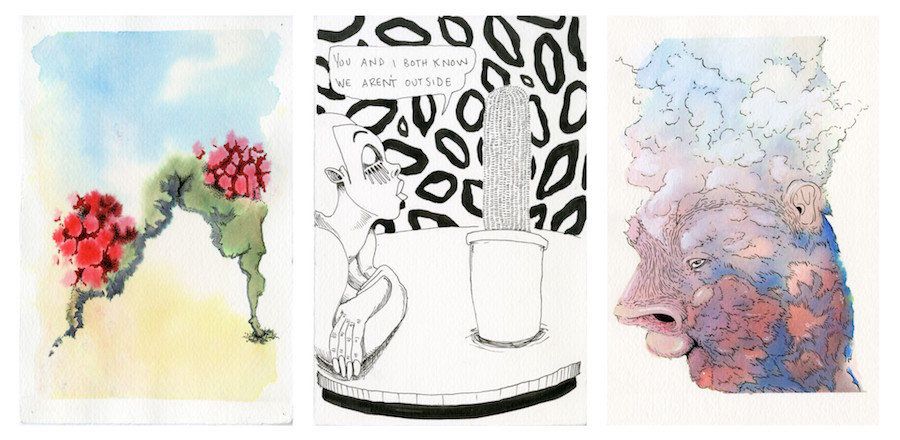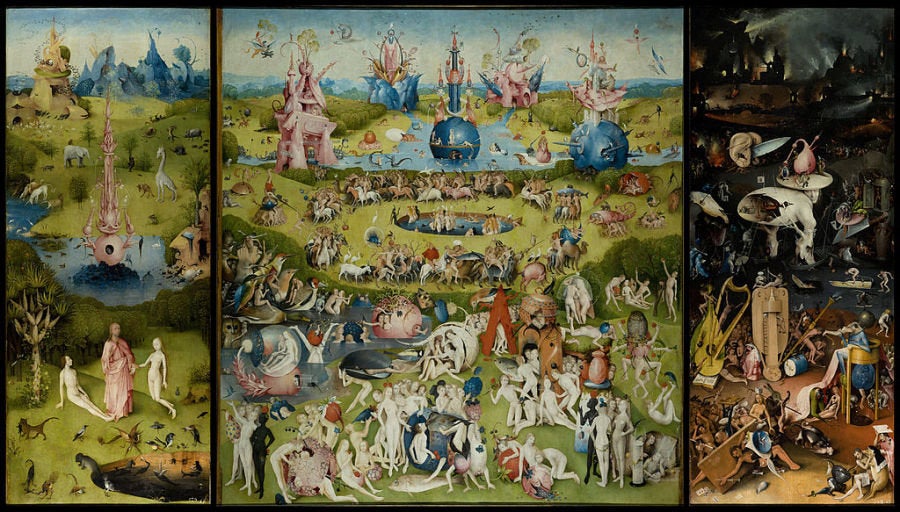Lucia Love describes her characters as "mixtures of flesh and pudding." Indeed, the New York-based multidisciplinary artist has a penchant for creations of questionable consistency, whose eyelids droop like jellyfish and ears erode into infinite chasms.
Love's work was recently on view with Albertz Benda Gallery at the NADA art fair in New York. Many of the exhibited works revolve around the tale of a telepathic cactus. According to Love, the malicious plant brainwashed women with the hopes of changing Earth's atmosphere to a brutal desert climate -- one more suitable for cacti. The possessed ladies then organized a satanic ritual involving the caging of innocent, young boys dangled above a tire fire. Eventually a deer, one who could resist the cacti's brainwashing methods, rescued the young boys.
If the concept sounds like a deliciously strange stew of violence, power dynamics and perversion, you're not far off. "I wanted to have all of these characters from different parts of my practice meet each other and see what would happen," Love explained to The Huffington Post.

Love was born in 1988 in New York. Her father worked as a photographer, her mother owned and designed for a women's clothing store. "I had a lot of art around me growing up," Love recalled. "My parents really liked going to museums and they prided themselves on being creative at life. They were really supportive, always telling me I should just go out there and make whatever I need to make. You know, do your thing."
As a kid, Love remembers being perplexed by so much of the "grown up" art she encountered, finding it, in her words, super boring. "There were some things I would look at and ask, 'Why would adults like this stuff? There are no animals in it!'"
One work, however, stood out: a painting in Love's family home that seemed to her as "old as time." It was called "Satyr and Nymph," made by Walter Shirlaw around 1860. "It was this tiny painting that had this even tinier flesh blob strewn on a rock in the middle," Love said. "It looked like a pair of dirty socks. It took me years to realize they were lovers. I'd just look into this blob forever and wonder if it was guts of murdered people nicely laying in the woods."
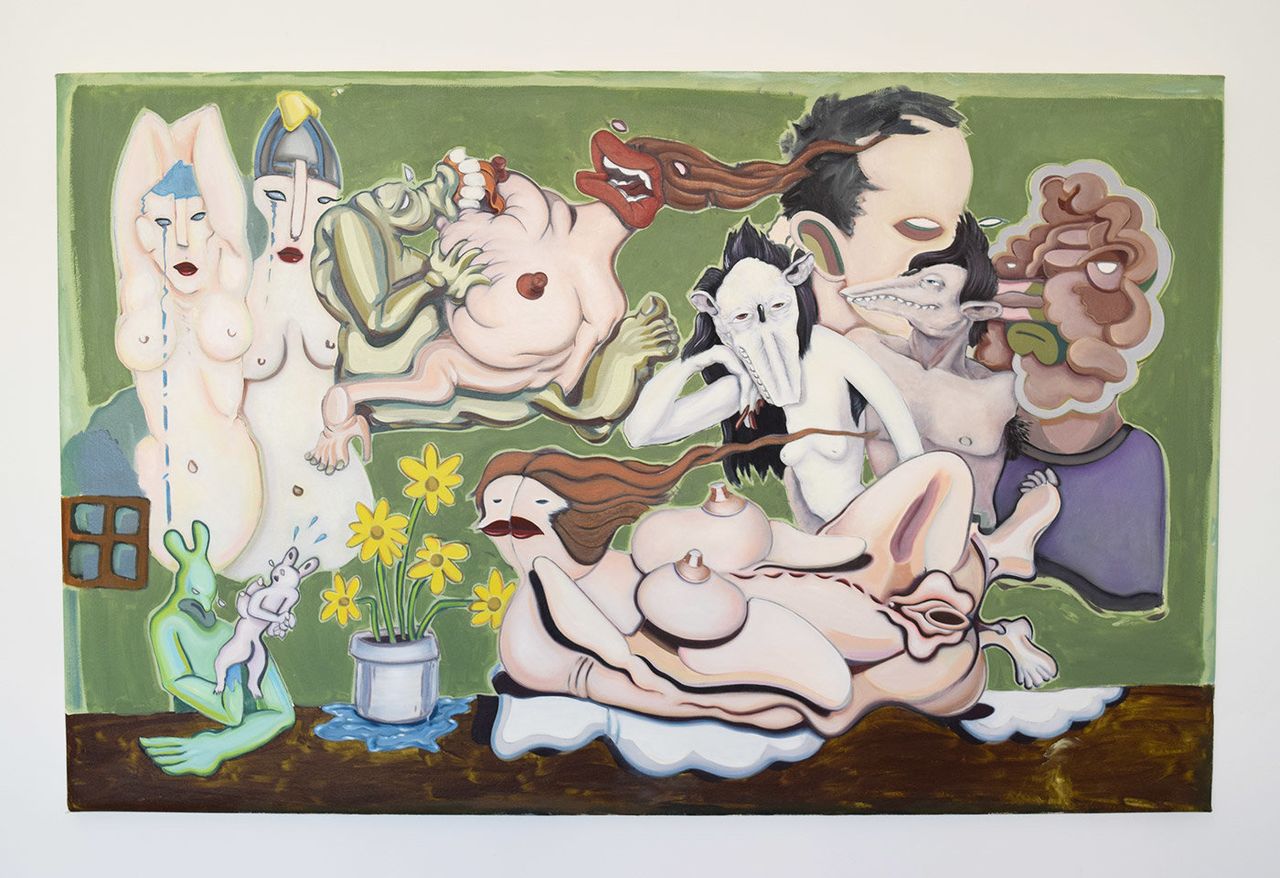
As a kid, Love mostly hung out with the chess club and enjoyed playing Magic: The Gathering. She mentioned feeling isolated by classmates whose topics of discussion seemed only to revolve around the latest episode of "Friends." Love herself did watch some television, namely the warped and kinky cartoons that graced the '90s with their awesome weirdness.
"When I was growing up," she said, "I had this magical experience -- I had a TV and I could put it on when nobody was watching and I could watch Adult Swim cartoons. It felt so deviant. It was basically video art."
The cartoon thing stuck. Love enrolled in New York's School of Visual Arts to study animation, to create characters she could breathe stories into. In school, she studied "The Ren & Stimpy Show" frame by frame. "They have this special way of moving characters and splatting them against stuff and adding those really close-up, nasty frames. It was such a cool time to be studying cartoons because people were finally allowed to make gnarly ones."
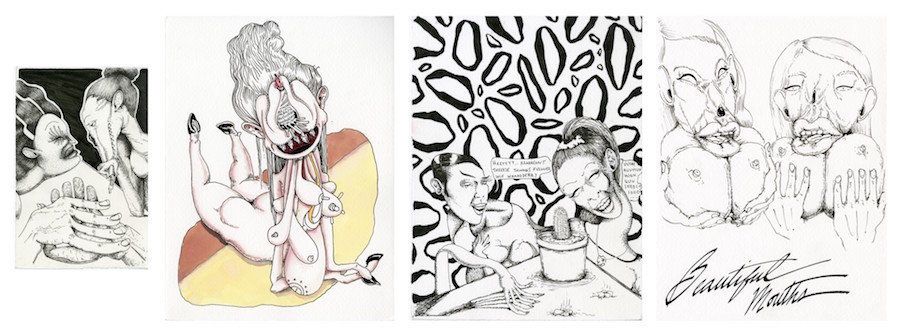
However, Love soon grew disappointed with the animation program's emphasis on marketability, which often came at the expense of personal style. She knew she wouldn't be happy drawing the background of a random film she knew nothing about. In other words: "I don’t want to make stupid shit! When you’re a kid you know what sucks even more than adults do. I don’t want to do something my 12-year-old self would kick me in the nuts for."
And so Love dragged her passion for animated strangeness into the fine art realm, painting unorthodox narrative scenes that combine the crispness of comics with the melting temperatures of surrealist and Cubist art.
Pioneered by artists like Peter Saul, Saul Steinberg and Philip Guston, the sweet melding of art and animation is having a moment. Dana Schutz, Jamian Juliano Villani, Eric Yahnker and recent MacArthur Grant winner Nicole Eisenman all usher the gross-out tactics of late-night cartoons into the pristine walls of the gallery space. Love is quite aware of animation's relevance, though not quite elated about it. "It’s kind of weird. A lot of people are talking about cartoons now," she said.
"Everybody wants to have that conversation of high art and low art clashing, bringing populist consumables into a more particular market," Love added. "To me it just feels so played out. Were German Expressionists doing their thing in response to Disney? No, that’s just how they saw people, as disgusting pigs. It was more of a political thing and less, 'Oh, we’re trying to do a little mashup and keep it fresh.'"
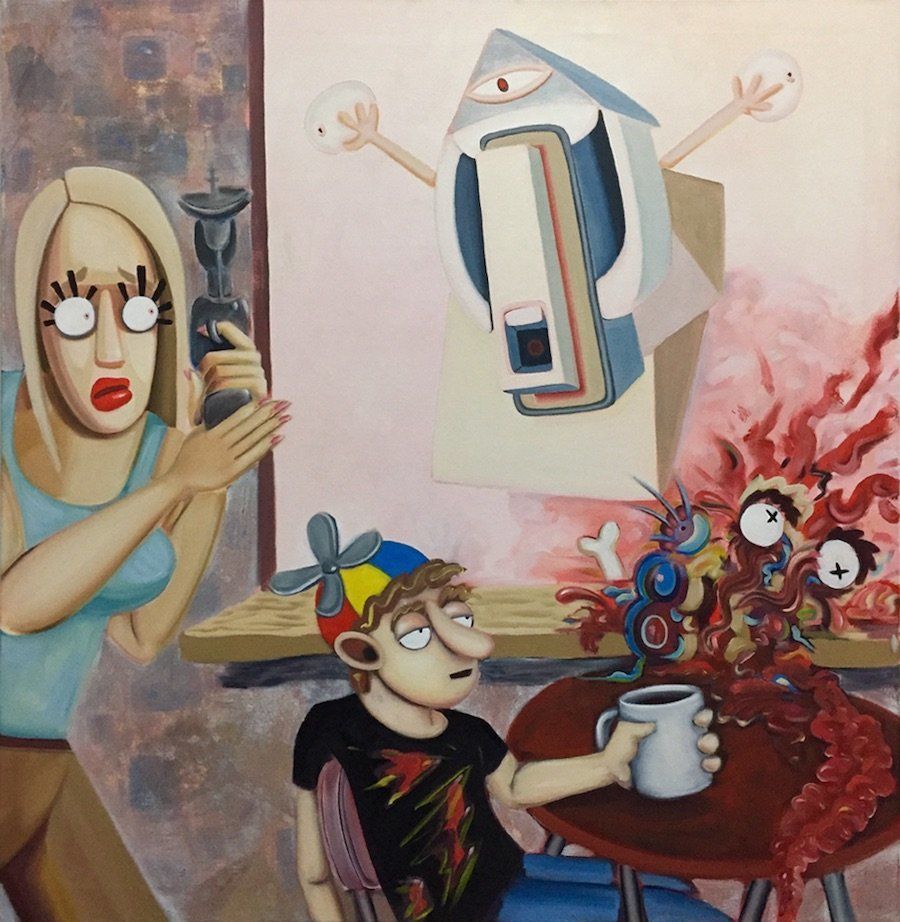
There is something palpably erotic, almost appallingly so, about Love's work, even if sex isn't explicitly depicted. Maybe it's all the tangling and oozing and blurring of boundaries, or perhaps it's the ecstatic emphasis on the body in all its animal glory, spitting and spewing and screaming and generally acting outside of established norms.
Love recalled reading Susan Sontag's lecture "On Classical Pornography," in which she compares comedy to pornographic texts like Marquis de Sade's Justine. Both, Sontag argues, require a certain emotional distance to be successful. We, as viewer and reader, do not enter the interior landscape of the characters on paper or on screen.
"The flayed, abused, pierced and violated victims of Sade don’t really suffer," Siri Hustvedt wrote in a piece on Sontag's lecture. "They are creatures of endless repetition -- more machine than human. The form creates a democratization of the text’s landscape, in which human beings and things mingle without defined borders in an abstract, unfeeling world."
Love recognizes this emotional distancing at work in her images as well. Just as when Sylvester the Cat, as the butt of the joke, is tortured mercilessly despite remaining obliviously calm. In both comedy and pornography, actions don't have the same consequences, physically and emotionally. People and things bump against each other with plastic resilience.
"Makes sense," Love commented. "There are only a few ways to release. One is to laugh, one is to come."

Although Love's artwork leaps wildly back and forth in style and subject matter like a cartoon character on a frantic and bumbling mission, her themes generally revolve around ideas of innocence, boundaries, power dynamics, and historical perverts. She's also repeatedly drawn to literary female characters like the aforementioned Justine, Vladimir Nabokov's Lolita and Milan Kundera's Tereza and Sabina, who embody such topics.
When attempting to describe her process, Love again veers into to erotic territory. "Process is such a weird thing. It’s like masturbating. When am I turned on? When do I want to do this? When do I have to do this? What do I want to watch while I’m doing this? Then you get hooked on a thing -- being vanilla or sadistic. It can come from anywhere, it’s just life."
With a wonderfully unhinged practice that drops telepathic cacti and Cubist nudes and exploding faces into the same, flattened world, Love has certainly achieved at least one goal. Her 12-year-old self would surely be proud.




